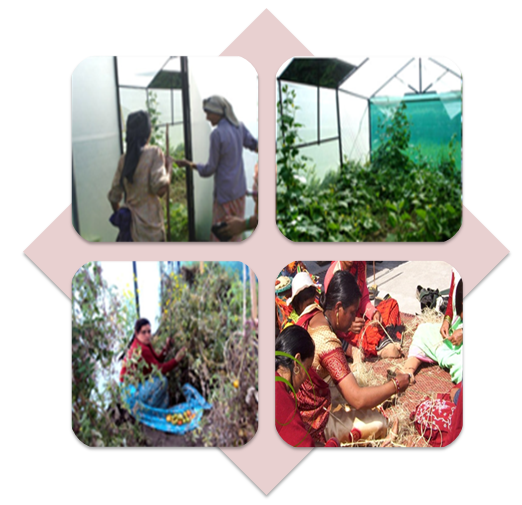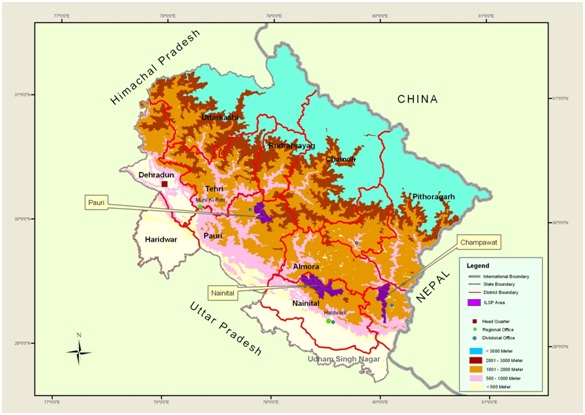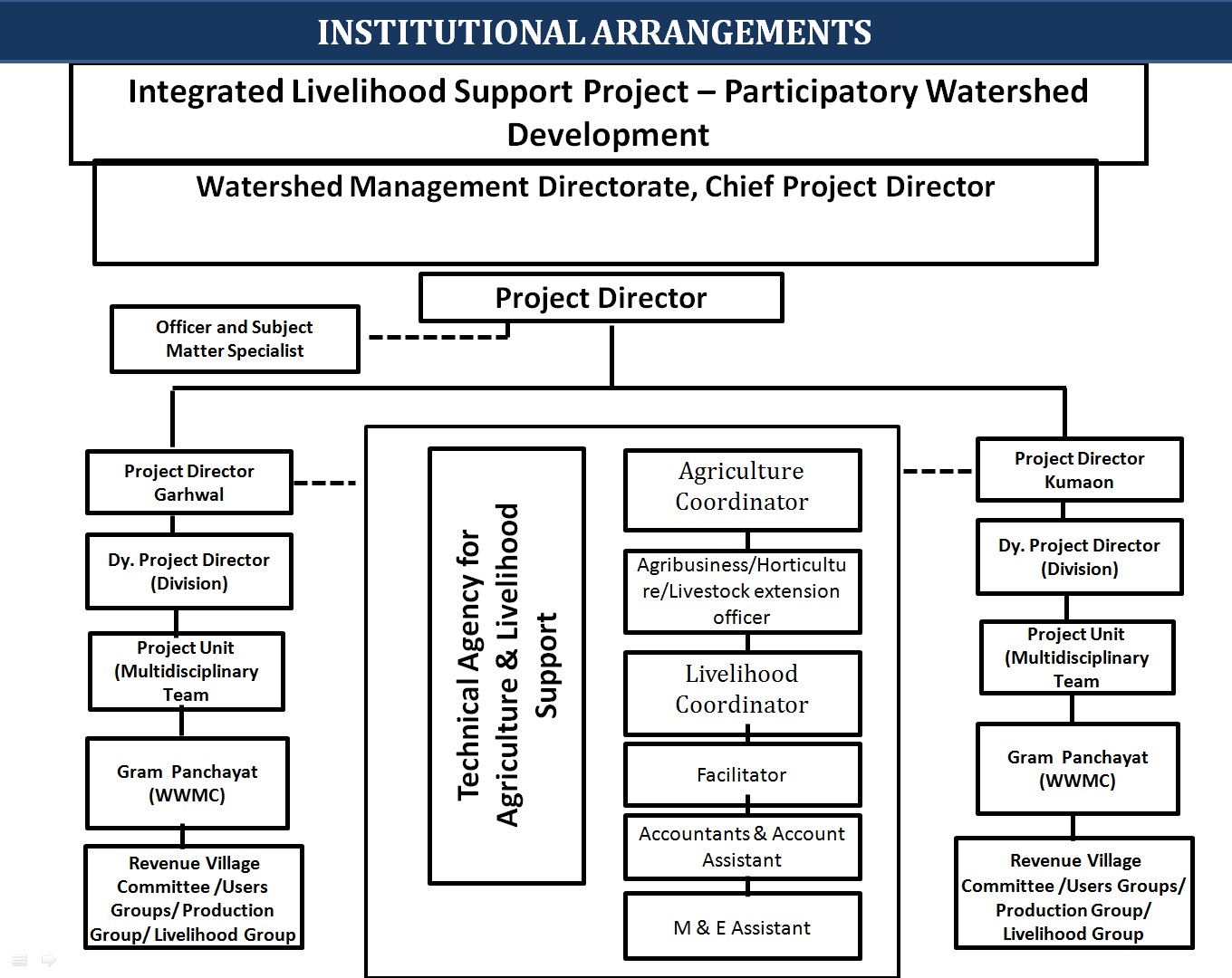| About Project |
| Strategy |
| Components of ILSP |
| Implementation Approach |
| Monitoring Arrangements |
| Project Cost |
| Result Monitoring |
| Project Period |
| Project Area |
| Institutional Structure of ILSP |
| Important Circular & Govt. Orders |
 Tenders & Advertisements |
|
|
| |

Background
The Uttarakhand Watershed Development Unit (UWDU) through Govt. of Uttarakhand has received a credit from IFAD (International Fund for Agriculture Development) for implementation of Integrated Livelihoods Support Project, (ILSP). The UWDU is PIA for Project Component -2: Participatory Watershed Development. The project development objective (PDO) is: The overall objective (goal) of ILSP will be to reduce poverty in hill districts of Uttarakhand. This would be achieved via the more immediate development objective of “enable rural households to take up sustainable livelihood opportunities integrated with the wider economy”.
Location:
Uttarakhand is a hill state in the north-west of India, covering 53,483 sq km with a population of about 10.0 million (2011 census). Nine of its 13 districts are classed as hill districts, covering 77% of the area of the state, but with only 44% of the population. Livelihoods are still predominantly rural, but most economic and population growth has also been in the plains, which are becoming industrialised.
Poverty:
Uttarakhand is one of the poorest states in India. The major driver of rural poverty is the difficult mountain environment. Land holdings are very small (average 0.8 ha) and fragmented into 6 or 7 different locations. Tiny terraced plots on steep hillsides makes mechanisation virtually impossible. Shallow and immature soils require high levels of organic matter, but yields are very low.
Agriculture is very largely for subsistence, but very few households are able to produce enough food to last for more than three or four months. People rely on non-farm earnings and safety net programmes. With few rural employment opportunities, more and more people are migrating to jobs outside of hill districts. Between one third and one half of households send migrants and, as it is mainly men who migrate, this places more and more of the burden of farm labour, as well as domestic work, on women. Lack of labour, low productivity and wild animal damage are all contributing to land being abandoned, and it is said that as much as 30% of land in the hills that was once used to grow crops is no longer in production.
Rationale:
The justification for ILSP is the need to stop the deterioration of the productive infrastructure, make farm labour more productive and farming more remunerative, and hence provide incentives for people to invest their time and resources in agriculture. Despite the disadvantages that agriculture faces in the hill areas, Uttarakhand does have the advantage of cooler temperatures at higher altitudes, allowing production of off-season vegetables and temperate fruits. The horticultural sector is less developed than in the other hill states, so there is considerable potential for growth, as there are other niche products such as spices, medicinal and aromatic plants, and nuts.
There is little use of modern varieties, mineral fertilisers and other inputs. Only about 10% of land in hill districts is irrigated. Most households keep cattle or buffalo, but improved crossbreds are relatively scarce, there is minimal investment in feeding and heath care. With 65% of the state covered in forest, damage to crops by wild animals is a major problem. Farmers and others report that the climate in Uttarakhand is changing, with rainfall patterns becoming more erratic.
Another area with growth potential is tourism. However more needs to be done to ensure that local people fully participate in, and benefit from, this sector. |
Strategy
The strategy behind ILSP will be to adopt a two pronged approach to building livelihoods in hill districts. The first of these is to support and develop the food production systems which remain the main means of support for most households. This involves improving technologies for production of traditional food crops and livestock, and developing supporting services for input supply and marketing of any surpluses. To make food production more secure the project will also contribute to watershed development to conserve water and soil resources. ILSP will also support the production of fodder and other non-timber forest products in community forest areas (Van Panchayats).
The second main thrust of the project is to generate cash incomes via the introduction and expansion of cash crops. These would be grown on a significant scale for markets outside of the state. There is already significant production of off-season vegetables, such as potatoes, tomatoes and peas, and some fruit. This can be expanded through improved technologies and the development of new production areas, with returns to farmers improved via better marketing and by value addition. ILSP will also support non-farm livelihoods, especially community involvement in rural tourism. Many people migrate to jobs outside of the hill areas, and ILSP will support vocational training to help people obtain more remunerative employment.
|
Components of ILSP
Component 1: Food security and livelihood enhancement
Component 2: Participatory Watershed Development
Component 3: Livelihood financing
Component 4: Project coordination and monitoring:
Under the ILSP Project PSWMD (Project Society Watershed Management Directorate) is having responsibility of implementing component-2(Participatory Watershed Development).
Participatory Watershed Development:
To implement component-2 Watershed Management Directorate (WMD) will use processes that have been established through a series of watershed development projects in the state, but with an increased focus on food security, livelihoods and market linkages. It will protect and improve the productive potential of the natural resources in selected watersheds, alongside the promotion of sustainable agriculture with formation of PGs and LCs, and with improved access to markets. The component would cover a total of 22 micro-watershed (MWS) covering an area of about 70194 ha in 3 clusters in 3 districts (Pauri, Champawat and Nainital), with a population of 103321.
Sub-components and activities to be implemented under Component-2 are as follows:
(a) Participatory Watershed Management
The involvement of stakeholders at grass root level is a vital element of watershed management. NGOs/TAs will be hired for social awareness and participatory planning for smooth running of project.
Watershed Development activities will be implemented on the basis of a budget allocation provided at the GP level calculated based on watershed area and total population. Within this allocation the communities will have to prioritize, implement, operate and maintain watershed and other priority investments of the village. The various activities will be Soil and Moisture Conservation Measures, water harvesting structures, plantations, pasture development, livestock support and encourage use of alternate energy sources.
(b) Food Security & Scaling Up
Producer Groups (PG) would be formed to introduce, promote and disseminate improved technologies and farming practices. Technical agency will be hired to support the project subcomponent by forming PGs,VPGs & LC and providing them technical support of agribusiness development, financial support, new agriculture technologies, value chain development.
(c) Access to Market:
Under this sub-component, the project will: (i) identify the market potential for the agricultural produce; (ii) develop collection centres and good storage facilities; (iii) create centres for value addition of the raw produce; and (iv) identify market linkages, develop market information and logistic services. The private sector (NGOs and private firms) will be encouraged to play a major role in supporting agribusiness development.
To up-scale production, develop markets for high value crops, and to leverage producers' access to production and marketing services, the project would support farmers to organise their PG and VPG into Livelihood Collectives(LCs). The project would provide input support to LCs. For financial support, PG/LC would be linked with banks and other financial institutions.
(d)Monitoring & Evaluation and Knowledge Management:
(i) Capacity Building of Watershed Committees, CBOs and all level of stakeholders.
(ii) Information, Education and Communication: targeted messages to increase general awareness about the project, terms of participation and transparency.
(iii) Project Management, Coordination, Monitoring and Evaluation.
|
Implementation approach
The Watershed Management Department will be responsible for implementation of this component. WMD would establish a society to implement the project. WMD has an established track record in implementing participatory watershed management projects. The implementation would be based on joint relationship among three entities: (i) village communities and GPs; (ii) WMD; and (iii) NGOs and other service providers. All these three stakeholders will fulfil their respective roles and responsibilities for the project to be successful. Specifically the roles of each entity are:
Village Community and GP: Will plan and implement the project
WMD: Provide overall coordination and assist the village communities and GPs
NGOs: Carry out social mobilization, may provide technical assistance and undertake project implementation and other activities as agreed to with GPs and WMD
Coordination
The Rural Development Department (RDD) will be the nodal agency at the state level. A Central Project Coordination Unit (CPCU) will be within the RDD. A state level Project Steering Committee (PSC) would be chaired by the Chief Secretary, GOUK. The PSC will establish a Project Management Committee (PMC) chaired by the Secretary of RDD and co-chaired by the Secretary of Watershed Management.
|
MONITORING ARRANGEMENTS IN THE PROJECT
The monitoring systems will generate management information systems (MIS) and provide the government and IFAD with evidence of results and impact against log frame indicators (and also for IFAD’s RIMS system). This will involve activity/output, process, outcome and impact monitoring.
Internal Monitoring: By the WMD staff, through MIS/GIS and Annual outcome surveys.
External Monitoring: Baseline Survey, mid-term review and final impact evaluation.
Social Audit: Participatory Monitoring and Evaluation (PM&E) at GP level by the Stakeholders.
Environmental and Social Safeguard Monitoring: Integrated with the development and implementation of the GP/MWS plans.
Evidence based monitoring: Short studies and consultancies on various aspects of the project by engaging external consultants and organizations.
Financial management
It will be on the lines of current IFAD funded projects in India. Tally Accounting software will be used to maintain accounting records and generate financial statements in IFAD formats. Periodic inputs from an IFAD Financial Management and Procurement Specialist will provide training and support for project financial staff. |
Total Project cost for the component- 2
The total project cost of Participatory Watershed Management Sub- Project is estimated to be INR 286.94 crores. The Project will be financed by an IFAD loan of INR 211.81 crores (73.82%), a contribution of State Govt. of INR 55.97 crores (19.51%), and INR 19.16 crores (6.67%) from beneficiaries. Significant additional funds will flow to members of project groups though convergence with other government programmes.
| |
Result Monitoring
The Results Frame Work of the Project identifies the key outcome and results indicators that are to be monitored and evaluated during the course of this project. These include:
|
| Objective Hierarchy |
Indicators (After MTR) |
Goal:
Reducing poverty in hill districts of Uttarakhand.
|
"
- Household assets.
- Food Security
- Quality of housing, water supply and sanitation.
|
Development Objective:
Enable 20000 rural households to take up sustainable livelihood opportunities integrated with the wider economy.
|
- 60% of households report increase in income from sub-sectors supported by the project, and in total income.
- 60% of households increase food security.
- Access to watershed natural resources improved for 70% of households.
- Women's empowerment- women in 50% of HH report improvements in decision making, assets, mobility.
|
| Outcomes: |
Participatory watershed management
22 project watersheds with a population of 20000 households become less vulnerable to erosion and drought
|
- Increase of 10% in vegetative biomass.
- Increase of 10% in water availability.
- 200 hac. of Fallow lands/barren land to be brought under cultivation.
- Increase 3800 hac. area under rainfed crop and production
|
Food Security & Livelihood up-scaling.
- Farming systems on 22 project watersheds become more productive.
- Livelihood opportunities for vulnerable HH and up-scaling of farm enterprises.
|
- 60% of farmers adopt new technologies and increase farm yield and/or output.
- 5% of HH establish new enterprises.
- 10% of HH expand existing enterprises.
- 60% federations and LCs operating successfully.
|
Access to Market.
- Improved market access for rural households
|
- 20% of farmers increase in sales of produce or use new market channels.
- 60% of producers aggregating of LC/Federation level to access market channel.
|
|
|
The objective of impact evaluation is to measurement of the degree to which the project has achieved its overall goal of poverty reduction. It is hoped that the impact evaluation will lead to an understanding of the extent to which project outputs have resulted in improved livelihoods, and in turn how these better livelihoods have reduced poverty. As well as quantifying benefits and estimating the degree to which such changes can be attributed to project interventions, the survey would investigate issues of equity and the degree to which women and disadvantaged households have been able to participate in the project and benefit from project outputs.
|
Project period
The project duration is 9 years (i.e.2012-2021) after restructuring in project mid term review and the project cycle in each GP will be of about 7 years in following three phases. The project will commence from Financial Year 2013-14.
The preparatory phase:-First 2 years
The Implementation Phase:- Fourth years
The Withdrawal Phase: - Seventh years.
|
Project Area:

|
Project District Under Component- 2 Participatory Watershed Development:
| S.No. |
District |
Development Blocks |
| 1 |
Pauri |
Pabo,Ekeshwar |
| 2 |
Champawat |
Pati, Champawat, Barakot |
| 3 |
Nainital |
Baitalgarh, Ramgarh |
Download GP/RV wise Village List
|
Institutional Structure of ILSP (Participatory Watershed Development Component)

|
Important Circular & Govt. Orders
|
|

 Nursery Plants
Nursery Plants
 Poly House Demonstration
Poly House Demonstration
 Womens Aam Shabha
Womens Aam Shabha
 Water Harvesting Tanks
Water Harvesting Tanks
 World Bank Visit
World Bank Visit
 High Yielding Agriculture Crops
High Yielding Agriculture Crops
 Veteranary camp
Veteranary camp
 Training Programme for womens
Training Programme for womens
 Agribusiness
Agribusiness
 Alternate Energy-Pine Briquettes
Alternate Energy-Pine Briquettes
 Tenders & Advertisements
Tenders & Advertisements 

